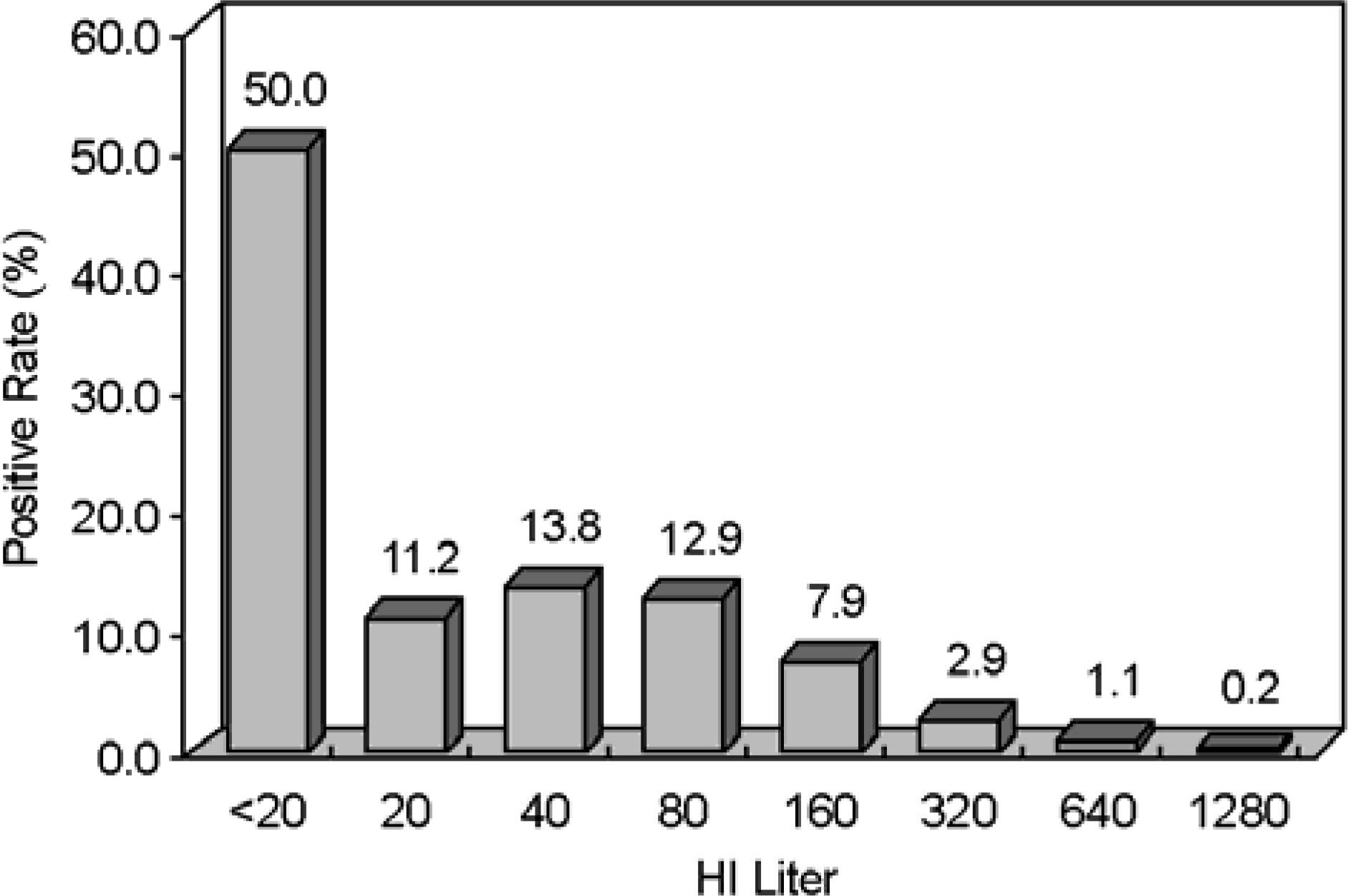J Bacteriol Virol.
2007 Jun;37(2):105-109. 10.4167/jbv.2007.37.2.105.
Serological Survey of Bovine Coronavirus in Korea
- Affiliations
-
- 1Animal Disease Diagnosis Division, National Veterinary Research and Quarantine Service, 480 Anyang 6-dong Anyang, Gyeonggi-do 430-824, Korea. yangdk@nvrqs.go.kr
- 2Virology Division, National Veterinary Research and Quarantine Service, 480 Anyang 6-dong Anyang, Gyeonggi-do 430-824, Korea.
- KMID: 2055044
- DOI: http://doi.org/10.4167/jbv.2007.37.2.105
Abstract
- Bovine coronavirus (BCoV) is a causative agent of entero-pathogenic diarrhea in young calves and winter dysentery (WD) in adult cattle. In this study, we conducted a nationwide sero-epidemiological survey of BCoV infection in Korea. In total, 3,029 bovine sera collected between October and December 2005 were screened for the presence of antibodies against BCoV using a hemagglutination inhibition (HI) test. Half (50.0%) of individual cattle tested were positive for BCoV. The regional distribution of the seroprevalence of positive HI antibodies was 55.7% (234/420) in Gyeonggi, 53.0% (316/596) in Jeonra, 51.9% (374/720) in Chungcheong, 48.5% (401/827) in Gyeongsang, 43.9% (79/180) in Jeju, and 38.1% (109/286) in Gangwon Province. Analyzing the distribution of HI titer according to the age of the cattle showed the highest BCoV seropositive rate in 5-year-old cattle, and the incidence of cattle with an HI antibody titer of 1:160 or above was 12.1%.
Keyword
MeSH Terms
Figure
Cited by 1 articles
-
Cross-reactivity of Vaccine and Fields Strains of Bovine Coronaviruses in Korea
Garam Lee, Jae-Young Song, In-Soo Cho, Sorah Yoon
J Bacteriol Virol. 2010;40(1):49-58. doi: 10.4167/jbv.2010.40.1.49.
Reference
-
References
1). 김병한. 최근 3년간 동물용생물학적제제 수급동 향. 수의과학검역정보지. 24:67–76. 2004.2). Alenius S, Niskanen R, Juntti N, Larsson B. Bovine coronavirus as the causative agent of winter dysentery: serological evidence. Acta Vet Scand. 32:163–170. 1991.3). Chung CW, CHo JJ, Cho IS, An SH, Jang MS. Isolation and characterization of Bovine coronavirus from calves and adult cows with diarrhea. RDA J Veterinary Sci. 39:11–18. 1997.4). El-Ghorr AA, Snodgrass DR, Scott FM, Campbell I. A serological comparison of bovine coronavirus strains. Arch Virol. 104:241–248. 1989.5). Fukutomi T, Tsunemitsu H, Akashi H. Detection of bovine coronaviruses from adult cows with epizootic diarrhea and their antigenic and biological diversities. Arch Virol. 144:997–1006. 1999.
Article6). Ganaba R, Belanger D, Dea S, Bigras-Poulin M. A seroepidemiological study of the importance in cow-calf pairs of respiratory and enteric viruses in beef operations from northwestern Quebec. Can J Vet Res. 59:26–33. 1995.7). Hasoksuz M, Lathrop SL, Gadfield KL, Saif LJ. Isolation of bovine respiratory coronaviruses from feedlot cattle and comparison of their biological and antigenic properties with bovine enteric coronaviruses. Am J Vet Res. 60:1227–1233. 1999.8). Hirano N, Ono K. A serological survey of human coronavirus in pigs of the Tohoku District of Japan. Adv Exp Med Biol. 440:491–494. 1998.
Article9). Hussain KA, Storz J, Kousoulas KG. Comparison of bovine coronavirus (BCV) antigens: monoclonal antibodies to the spike glycoprotein distinguish between vaccine and wild-type strains. Virology. 183:442–445. 1991.
Article10). Jeong JH, Kim GY, Yoon SS, Park SJ, Kim YJ, Sung CM, Jang OJ, Shin SS, Koh HB, Lee BJ, Lee CY, Kang MI, Kim HJ, Park NY, Cho KO. Detection and isolation of winter dysentery bovine coronavirus circulated in Korea during 2002–2004. J Vet Med Sci. 67:187–189. 2005.11). Kapil S, Richardson KL, Maag TR, Goyal SM. Characterization of bovine coronavirus isolates/from eight different states in the USA. Vet Microbiol. 67:221–230. 1999.
Article12). Ko CK, Kang MI, Lim GK, Kim GY, Yoon SS, Park JT, Jeong C, Park SH, Park SJ, Kim YJ, Jeong JH, Kim SK, Park SI, Kim HH, Kim KY, Cho KO. Molecular characterization of HE, M, and E genes of winter dysentery bovine coronavirus circulated in Korea during 2002–2003. Virus Genes. 32:129–136. 2006.
Article13). O'Connor A, Martin SW, Nagy E, Menzies P, Harland R. The relationship between the occurrence of undifferentiated bovine respiratory disease and titer changes to bovine coronavirus and bovine viral diarrhea virus in 3 Ontario feedlots. Can J Vet Res. 65:137–142. 2001.14). Reynolds DJ, Debney TG, Hall GA, Thomas LH, Parsons KR. Studies on the relationship between coronaviruses from the intestinal and respiratory tracts of calves. Arch Virol. 85:71–83. 1985.
Article15). Saif LJ. Coronavirus immunogens. Vet Microbiol. 37:285–297. 1993.
Article16). Sato K, Inaba Y, Matumoto M. Serological relation between calf diarrhea coronavirus and hemagglutinating encephalomyelitis virus. Arch Virol. 66:157–159. 1980.
Article17). Takamura K, Okada N, Ui S, Hirahara T, Shimizu Y. Protection studies on winter dysentery caused by bovine coronavirus in cattle using antigens prepared from infected cell lysates. Can J Vet Res. 64:138–140. 2000.18). Taniguchi S, Iwamoto H, Fukuura H, Ito H, Kaige N, Nagoto Y. Recurrence of bovine coronavirus infection in cows. J Jpn Vet Med Assoc. 39:298–302. 1986.
Article19). Timoney JF, Gillespie JH, Scott FW. Barlough: Bovine coronavirus infection. Pp. p. 902–905. In Hagan and Bruner's microbiology and infectious diseases of domestic animals. 8th ed.Cornell University Press;New York: 1988.20). Traven M, Bjornerot L, Larsson B. Nationwide survey of antibodies to bovine coronavirus in bulk milk from Swedish dairy herds. Vet Rec. 144:527–529. 1999.21). Tsunemitsu H, el-Kanawati ZR, Smith DR, Reed HH, Saif LJ. Isolation of coronaviruses antigenically indistinguishable from bovine coronavirus from wild ruminants with diarrhea. J Clin Microbiol. 33:3264–3269. 1995.
Article22). Tsunemitsu H, Saif LJ. Antigenic and biological comparisons of bovine coronaviruses derived from neonatal calf diarrhea and winter dysentery of adult cattle. Arch Virol. 140:1303–1311. 1995.
Article
- Full Text Links
- Actions
-
Cited
- CITED
-
- Close
- Share
- Similar articles
-
- Serological survey for Getah virus in domestic pigs of South Korea
- Targeted RNA recombination of the membrane and nucleocapsid protein genes between mouse hepatitis virus and bovine coronavirus
- Infectivity of bovine leukemia virus to Korean native goats I. antibody responses and syncytium assay for Korean native goats experimentally infected with bovine leukemia virus
- A Chinese Case of Coronavirus Disease 2019 (COVID-19) Did Not Show Infectivity During the Incubation Period: Based on an Epidemiological Survey
- Brain invasion of bovine coronavirus: Virology molecular analysis of bovine coronavirus infection in calves with severe pneumonia and neurological signs


